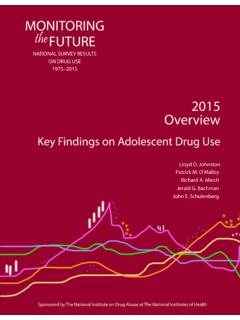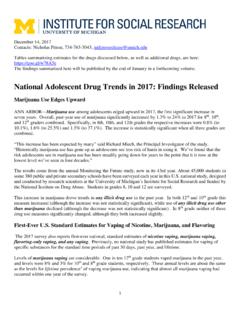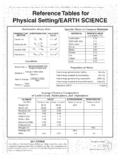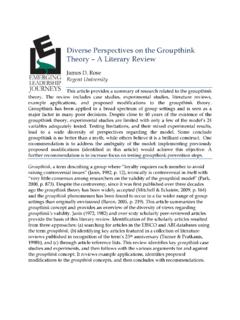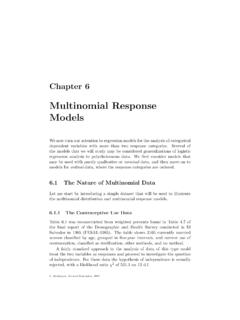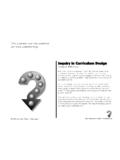Transcription of MONITORING THE FUTURE
1 MONITORING THE FUTURE NATIONAL RESULTS ON ADOLESCENT DRUG USE Overview of Key Findings, 2011 by Lloyd D. Johnston, Patrick M. O Malley, Jerald G. Bachman, John E. Schulenberg, The University of Michigan Institute for Social Research Sponsored by: The National Institute on Drug Abuse National Institutes of Health This publication was written by the principal investigators and staff of the MONITORING the FUTURE project at the Institute for Social Research, the University of Michigan, under Research Grant No. 3 R01 DA 01411 from the National Institute on Drug Abuse. The findings and conclusions in this report are those of the authors and do not necessarily represent the views of the sponsor. Public Domain Notice All material appearing in this volume is in the public domain and may be reproduced or copied without permission from the authors.
2 Citation of the source is appreciated. Recommended Citation Johnston, L. D., O Malley, P. M., Bachman, J. G., & Schulenberg, J. E. (2012). MONITORING the FUTURE national results on adolescent drug use: Overview of key findings, 2011 . Ann Arbor: Institute for Social Research, The University of Michigan. Institute for Social Research The University of Michigan Ann Arbor, Michigan Printed February 2012 Contents Introduction .. 1 Study Design and Methods .. 3 Summary of Key Findings .. 5 Specific Results by Drug Any Illicit Drug .. 10 Marijuana .. 12 Inhalants .. 14 LSD .. 16 Cocaine .. 18 Crack .. 20 Amphetamines .. 22 Methamphetamine and Crystal Methamphetamine (Ice) .. 24 Heroin .. 26 Other Narcotic Drugs, Including OxyContin and Vicodin .. 28 Tranquilizers .. 30 Sedatives (Barbiturates) .. 32 Ecstasy (MDMA) and Other Club Drugs .. 34 Alcohol.
3 36 Cigarettes .. 38 Smokeless and Other Forms of Tobacco .. 40 Steroids .. 42 Subgroup Differences .. 44 Tables Covering All Drugs 1. Trends in Lifetime Prevalence of Use of Various Drugs for Grades 8, 10, and 12 Combined .. 46 2. Trends in Annual Prevalence of Use of Various Drugs for Grades 8, 10, and 12 Combined .. 47 3. Trends in 30-Day Prevalence of Use of Various Drugs for Grades 8, 10, and 12 Combined .. 48 4. Trends in Daily Prevalence of Use of Selected Drugs for Grades 8, 10, and 12 Combined .. 49 5. Trends in Lifetime Prevalence of Use of Various Drugs in Grades 8, 10, and 12 .. 50 6. Trends in Annual Prevalence of Use of Various Drugs in Grades 8, 10, and 12 .. 56 7. Trends in 30-Day Prevalence of Use of Various Drugs in Grades 8, 10, and 12 .. 61 Contents (continued) 8. Trends in 30-Day Prevalence of Daily Use of Various Drugs in Grades 8, 10, and 12.
4 65 9. Trends in Harmfulness of Drugs as Perceived by 8th Graders .. 66 10. Trends in Harmfulness of Drugs as Perceived by 10th Graders .. 67 11. Trends in Harmfulness of Drugs as Perceived by 12th Graders .. 68 12. Trends in Disapproval of Drug Use in Grade 8 .. 71 13. Trends in Disapproval of Drug Use in Grade 10 .. 72 14. Trends in Disapproval of Drug Use in Grade 12 .. 73 15. Trends in Availability of Drugs as Perceived by 8th Graders .. 75 16. Trends in Availability of Drugs as Perceived by 10th Graders .. 76 17. Trends in Availability of Drugs as Perceived by 12th Graders .. 77 Introduction MONITORING the FUTURE (MTF) is a long-term study of American adolescents, college students, and adults through age 50. It has been conducted annually by the University of Michigan s Institute for Social Research since its inception in 1975 and is supported under a series of investigator-initiated, competing research grants from the National Institute on Drug Abuse.
5 The need for a study such as MTF is clear. Substance use by American young people has proven to be a rapidly changing phenomenon, requiring frequent assessments and reassessments. Since the mid-1960s, when it burgeoned in the general youth population, illicit drug use has remained a major concern for the nation. Smoking, drinking, and illicit drug use are leading causes of morbidity and mortality, during adolescence as well as later in life. How vigorously the nation responds to teenage substance use, how accurately it identifies the emerging substance abuse problems, and how well it comes to understand the effectiveness of policy and intervention efforts largely depend on the ongoing collection of valid and reliable data. MONITORING the FUTURE is uniquely designed to generate such data in order to provide an accurate picture of what is happening in this domain and why, and the study has served that function well for the past 37 years.
6 Policy discussions in the media, in government, education, public health institutions, and elsewhere have been informed by the ready availability of extensive and consistently accurate information from the study relating to a large number of substances. Similarly, the work of organizations and agencies providing prevention and treatment services is informed by MTF. The 2011 the MTF survey encompassed about 46,700 8th-, 10th-, and 12th-grade students in 400 secondary schools nationwide. The first published results are presented in this report. Recent trends in the use of licit and illicit drugs are emphasized, as well as trends in the levels of perceived risk and personal disapproval associated with each drug. This study has shown these beliefs and attitudes to be particularly important in explaining trends in use.
7 In addition, trends in the perceived availability of each drug are presented. A synopsis of the design and methods used in the study and an overview of the key results from the 2011 survey follow this introductory section. These are followed by a separate section for each individual drug class, providing figures that show trends in the overall proportions of students at each grade level (a) using the drug, (b) seeing a great risk associated with its use (perceived risk), (c) disapproving of its use (disapproval), and (d) saying they could get it fairly easily or very easily if they wanted to (perceived availability). For 12th graders, annual data are available since 1975, and for 8th and 10th graders, since 1991, the first year they were included in the study. The tables at the end of this report provide the statistics underlying the figures; in addition, they present data on lifetime, annual, 30-day, and (for selected drugs) daily For the sake of brevity, we present these prevalence statistics here only for the 1991 2011 interval, but statistics on 12th graders are available for earlier years in other MTF publications.
8 For each prevalence period, the tables indicate which of the most recent one-year changes (between 2010 and 2011 ) are statistically significant. The graphic depictions of multiyear trends often indicate gradual, continuing change that may not reach significance in a given one-year interval. A much more extensive analysis of the study s findings on secondary school students may be found in Volume I, the second monograph in this series, which will be published later in Volume I contains a more complete description of the study s methodology as well as an appendix explaining how to test the significance of differences between groups and of trends over time. The most recent such volume is always available on the MTF website, , listed under Publications. 1 Prevalence refers to the proportion or percentage of the sample reporting use of the given substance on one or more occasions in a given time interval , lifetime, past 12 months, or past 30 days.
9 For most drugs, the prevalence of daily use refers to reported use on 20 or more occasions in the past 30 days, except for cigarettes and smokeless tobacco, for which actual daily use is measured, and for binge drinking, defined as having 5+ drinks on at least one occasion in the prior two weeks. 2 The most recent publication in this series is Johnston, L. D., O Malley, P. M., Bachman, J. G., & Schulenberg, J. E. ( 2011 ). MONITORING the FUTURE national survey results on drug use, 1975 2010: Volume I, Secondary school students. Ann Arbor: Institute for Social Research, The University of Michigan, 744 pp. 1 MTF s findings on American college students and adults through age 50 are not covered in this early Overview report because the data from those populations become available later in the year.
10 These findings will be covered in Volume II, the third monograph in this annual series, which will be published later in A fourth monograph, HIV/AIDS; Risk and Protective Behaviors Among Young Adults, dealing with national trends in HIV/AIDS-related risk and protective behaviors among young adults 21 to 30 years old, was added to the series in For the publication years prior to 2010, the volumes in these annual series are available 3 The most recent publication in this series is: Johnston, L. D., O Malley, P. M., Bachman, J. G., & Schulenberg, J. E. ( 2011 ). MONITORING the FUTURE national survey results on drug use, 1975 2010: Volume II, College students & adults ages 19 50. Ann Arbor: Institute for Social Research, The University of Michigan, 312 pp.

